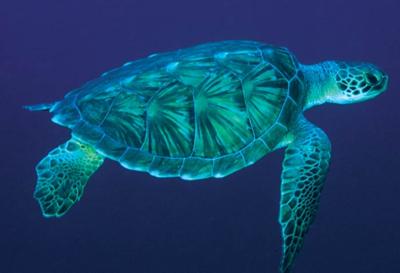by Naomi
(Sydney)

Sea Turtle
Sea turtles appeared in the Cretaceous period and survived the extinc¬tion of the dinosaurs by 65 million years. Now they face the greatest peril of their 110-million-year existence, us. The progressively diminish¬ing number of sea turtles on Earth is a direct result of human actions. Sea turtles (Superfamily Chelonioidea) are turtles found in all the world’s oceans except the Arctic Ocean. There are seven living species of sea turtles: Flatback, Green, Hawksbill, Kemp’s Ridley, Leatherback, Loggerhead and Olive Ridley. All species except the Leatherback are in the family Cheloniidae; the Leatherback belongs to the family Dermochelyidae and is its only member. Six out of seven sea turtles are endangered.
Hazards to Sea Turtles
Fisheries Impacts: Fisheries – impact sea turtles virtually everywhere. By catch mortality, habitat destruction and food web changes are the most severe of these impacts.
Coastal Development: Coastal development alters damages and destroys sea turtle habitats through nesting beach degradation, seafloor dredging, vessel traffic, construction, and alteration of vegetation.
Direct Take: Throughout the world, people kill sea turtles and consume their eggs for food and for products such as oil, leather and shell.
Pollution and Pathogens: Marine pollution such as plastics, discarded fishing gear, petroleum, and other debris. These directly impact sea turtles through ingestion and entanglement. Light pollution disrupts nesting behaviour and hatchling orientation, leading to hatchling mortality. Chemical pollutants can weaken sea turtles’ immune systems, making them susceptible to pathogens.
Global Warming: Global warming may impact natural sex ratios of hatchlings; escalate the frequency of extreme weather events; increase the likelihood of disease outbreaks among sea turtles; and result in loss of nesting beaches, destruction of coral reefs and other alterations critical to sea turtle habitats and basic oceanographic processes. Turtles lack sex chromosomes. Their genes do not directly determine whether a hatchling comes out male or female. Instead, buried eggs take their cue from the ambient temperature. For leatherbacks, temperatures below 29.4 degrees C produce a clutch that is mostly male; above that, it’s mostly female. With a mere 2 degree C increase, a nest will produce all females. A few degrees higher yet, and the “boiled” eggs don’t hatch at all. In order to maintain a viable breeding population, a cool, all male-producing year has to come at least once every five to 10 years, if male years begin to come only every 20 years because of climate change, the turtle could become extinct.
There is still so much information on sea turtles that we do not know even though they are one of the longest living creatures on earth as well as being loved worldwide. Tracking a sea turtles is near impossible due to the fact only females come back to shore to lay their eggs in the same place they were born (if possible).
These are seven commonly asked questions by scientists and researchers that still remain a mystery.
*Where do sea turtles spend their first years of life?
*What are the ecological roles of sea turtles, and how many turtles are needed to fulfil those roles?
*What proportion of males to females is necessary to maintain a healthy sea turtle population?
*How do sea turtles sense their environment?
*How do sea turtles navigate?
*What causes fibropapillomas?
*How will climate change affect sea turtles?
Scientists worry that climate change, on top of ongoing stresses, could deal the final blow to these creatures. Ongoing threats include habitat loss, poaching, and being caught in nets and on hooks intended for other prey. Now with Global Warming, scientists foresee stronger storms increasing erosion of the sandy beaches the turtles use to nest. Rising seas will flood existing beaches, even as human development halts natural beach migration inland and upland. Shifting currents may alter the ocean’s upwelling patterns, which turtles depend on for food. Finally, there’s global warming’s most unswerving effect more heat will devastate the sea turtle population due the unbalance ratio of female and male hatchlings.
